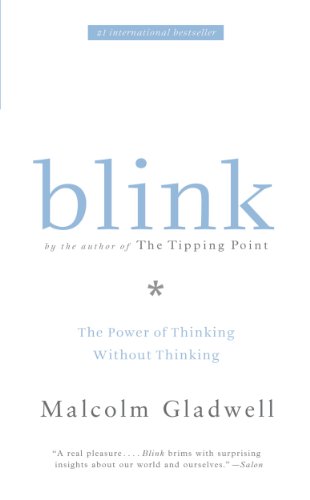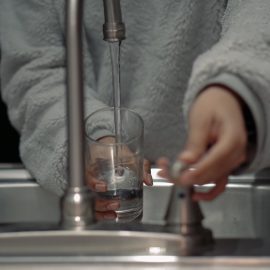

This article is an excerpt from the Shortform summary of "Blink" by Malcolm Gladwell. Shortform has the world's best summaries of books you should be reading.
Like this article? Sign up for a free trial here .
What is Malcolm Gladwell’s Blink about? What can Gladwell teach you about decision-making?
In his book Blink: The Power of Thinking Without Thinking (2005), Malcolm Gladwell argues that snap decisions made on the fly could be as good as decisions made through deliberate, rational thinking. Blink delves into how and why we make the gut decisions we do, when it’s unsafe to trust our guts, and what we can do to make all our snap judgments smarter, less biased, and more efficient.
Here’s an overview of Blink by Malcolm Gladwell.
Blink by Malcolm Gladwell
Most of us have been taught that to make good decisions we need to put in a lot of time and effort. In Blink: The Power of Thinking Without Thinking, Malcolm Gladwell questions this assumption, asking: How do our snap judgments compare to our rational, well-thought-out decisions? He finds that our snap judgments are often just as good as our deliberate decisions.
A New Yorker staff writer, Gladwell has made his name writing books that make social science research accessible and digestible to the layperson. His books include The Tipping Point (2000), Outliers (2008), David and Goliath (2013), and Talking to Strangers (2019).
Gladwell’s personal experience with racial stereotyping prompted him to research and write Blink. When Gladwell, who is half-Jamaican, let his hair grow, he noticed that police and security guards began to treat him differently. He was issued more speeding tickets and targeted by the police as a potential rapist. This led him to think more carefully about the far-reaching effects of snap judgments.
The Power of Snap Judgments
We usually think of snap judgments as lazy, superficial, and probably wrong. But are they really? Gladwell argues that snap judgments can be just as good as—or even better than—the decisions that we make by analyzing a situation carefully.
According to Gladwell, both logical, conscious decision-making and snap judgments have their time and place. Our brain uses two broad strategies for making decisions:
Strategy #1: Conscious Thinking
This thinking is also known as rational decision-making. When we think consciously, we use past experiences and current information to make a decision logically.
Strategy #2: Unconscious Thinking
This thinking is also known as the adaptive unconscious, intuition, or making snap judgments. When we think unconsciously, we make decisions without understanding why, or sometimes even without realizing we’ve made them.
Gladwell says we use these two different thinking strategies in different situations.
Benefits of Snap Judgments
According to Gladwell, snap judgments have two main benefits:
1) They’re unconscious. To make snap judgments, our unconscious minds “thin-slice”: They find patterns in situations based on small snapshots of experience.
Snap judgments don’t require a lot of information. When we thin-slice, our unconscious mind picks out the relevant information and leaves the rest. This allows us to ignore distracting, superficial details and get to the heart of a problem or choice.
When we thin-slice, we take small segments of experience and generalize them to make broader judgments. For example, when you meet someone for the first time, you might use his mood, outfit, or voice to make judgments about his personality and likeability.
(Shortform note: Gladwell doesn’t attribute the term “thin-slicing” to anyone in particular, and he’s often credited with coining it. But the idea of “thin slices” of experience first appears in a 1992 paper by Nalini Ambady and Robert Rosenthal that Gladwell draws on in some of his examples.)
2) They’re fast. The unconscious mind processes little bits of information and makes decisions about them all the time without our awareness. This frees up the conscious mind to focus on tasks that only it can complete, like those involving logic.
(Shortform note: In Thinking, Fast and Slow, Kahneman explains that snap judgments—his System 1—are fast because they work associatively. Associations, for example associating the word “lettuce” with salads and the color green, happen at lightning speed in the brain. They’re so fast and automatic that we can’t block them even if we try.)
Drawbacks of Snap Judgments
However, Gladwell notes, we need to beware of the downside of snap judgments:
1) We can get distracted by superficial information. To illustrate this problem, Gladwell gives the example of the 29th president of the United States, Warren Harding. Harding had an undistinguished political career. He wasn’t particularly smart, rarely took a stance on (or interest in) political issues, gave vague speeches, and spent much of his time drinking and womanizing. But still, he became president. How did he get the position in the first place?
As Gladwell notes, Harding looked like a president. His distinguished appearance and deep, commanding voice won voters over. They unconsciously believed that good-looking people make competent leaders. Harding’s looks and presence triggered associations so powerful they overrode voters’ ability to look below the surface, at his qualifications (or lack thereof). When we’re similarly influenced by superficial but irrelevant qualities, Gladwell says we’re making a “Warren Harding error.”
(Shortform note: “Warren Harding errors” are known in psychology as the halo effect. This is our tendency to allow positive impressions of someone (based on their appearance, clothing, or voice) to influence our judgments about other personal characteristics such as intelligence and morality. Psychologists have found that competent-looking faces predict positive election outcomes and that both physical and vocal attractiveness affect candidate ratings. The halo effect applied in reverse—for example, the fact that unattractive people are judged as more likely to commit crimes—is known as the “horn effect.”)
2) We can fall prey to unconscious biases we don’t even know we have. As Gladwell points out, our snap judgments can be both the product and the root of prejudice and discrimination. Our attitudes about race and gender, for instance, operate on two levels.
- Our conscious attitudes are what we choose to believe and how we choose to behave. They are the source of our deliberate decisions.
- Our unconscious attitudes are our unthinking, automatic associations.
Mismatches between these two levels can lead us to behave in a biased manner even when we think we’re being impartial.
(Shortform note: One example of how our unconscious attitudes influence our thinking is the “name-letter effect.” Research has shown that we favor romantic partners whose names contain similar letters to our own names. Why do we do this? It’s probably because of implicit egotism: We like ourselves, therefore we like the letters in our own names. But this motivation is hidden from our conscious minds.)
As Gladwell points out, when we act automatically, we depend on our implicit attitudes. If you have strong pro-white associations, you’ll act differently around someone who’s Black, probably without even being aware that you’re behaving differently. You might show less positive emotion or make less eye contact. If the Black person starts to mirror your behavior, you might then judge them negatively based on their lack of eye contact. This vicious circle has particularly detrimental effects in high-stakes situations, for example job interviews or police stops.
3) We’re susceptible to priming.
“Priming,” a technique in which you’re exposed to something that affects your responses for a short period of time, may also influence our snap decisions. Gladwell points to research evidence on priming that finds our unconscious minds to be extremely suggestible.
Most of the classic studies on priming use images presented subliminally. However, there are other ways to trigger this effect: For example you can use particular words in the lead-up to a task, or ask for particular information about the participants (sto influence the result.
These experiments show us that priming can have devastating effects on our unconscious attitudes and, consequently, our lives. But they also show us a path forward. If we can negatively influence our hidden attitudes, we can also positively influence them.
(Shortform note: The effectiveness of priming is debatable, and priming-related findings have been one of the major casualties of the reproducibility crisis in scientific research. Many follow-up studies on priming have failed to replicate the original results, suggesting that the results were either cherry-picked to yield the best results, statistically manipulated, or, at worst, fabricated. At best, priming is a more complex phenomenon than was thought at the time Gladwell wrote Blink.)
Snap Judgments Are a Mystery
A further problem with snap judgments is that we don’t have a good understanding of how they work.
As Gladwell points out, we’re often unable to explain why or how we arrive at a snap judgment, even if that judgment is correct. We know something, but we don’t know how we know it, and that’s frustrating. It’s hard to trust something that you can’t explain.
Because most of us don’t feel comfortable if we don’t know exactly what made us arrive at a particular snap judgment, we tend to rationalize, or invent inaccurate explanations for our actions or thoughts.. But instead of helping us to uncover the truth, rationalizing often takes us further away from it. We don’t lie on purpose, though: We actually believe the lies that our conscious minds construct to explain the decisions of the unconscious mind.
There are two problems with rationalizing our snap judgments:
Problem #1: Rationalizing leads to inaccurate explanations of our decisions.
Gladwell discusses the Problem of the Two Ropes to demonstrate how far our rational explanations can veer from the truth. In a 1931 study, psychologist Norman Maier hung two ropes from the ceiling in a room that also contained various items of furniture and other tools. The ropes were far enough apart that if you held one rope in your hand, you couldn’t reach the other. He asked volunteers to come up with as many ways to tie the two ropes together as they could. There were three obvious solutions using the furniture and tools provided, which most people figured out fairly easily. There was also a fourth, non-obvious solution: set one of the ropes swinging, go stand next to the other, and grab the swinging rope before tying them together.
If a volunteer was having trouble producing this fourth solution, the psychologist walked across the room and casually bumped into one of the ropes, causing it to swing. The move was so subtle that volunteers’ unconscious minds picked up on the suggestion while their conscious minds didn’t. After that, most people came up with the fourth solution.
- When asked to explain how they came up with the fourth solution, volunteers said, for example, that the solution came to them when they thought of monkeys swinging in trees, they recalled something from a physics lesson, or the idea just popped into their head.
These people weren’t lying. They were just automatically producing explanations that their conscious brains found most plausible. They had no idea the psychologist had given them the answer when he bumped the rope.
Problem #2: Rationalizing leads to worse decision-making and performance.
Gladwell points out that language is the primary tool of the rational mind. Using language (and therefore activating our rational minds) when a task is better completed by the unconscious mind can snuff out insights.
Think about any stranger you saw today, maybe the barista who made your morning coffee. Suppose someone asked you to describe the barista in as much detail as possible, including facial features, hair color, clothing, and jewelry.
If you had to pick this person out of a lineup, you’d do much worse after describing him or her than before. The act of describing erases the image from your mind by pulling it forward from the unconscious to the conscious.
This is verbal overshadowing. Instead of remembering what you saw, you’re remembering your description, which, due to the limits of language, will always be less accurate than your visual memory. When you explain yourself, you override the complex experience that you’re explaining. (Shortform note: Verbal overshadowing doesn’t only apply to faces. It also affects other visual memories, as well as our memories of tastes and sounds.)
How to Counter the Problems Caused By Rationalization
You have two options to stop rationalization from getting in the way of good decisions.
Gladwell’s Option #1: Don’t try to explain your snap decisions. Honor the mysteries of the unconscious mind and admit that you don’t always have the answers, even those pertaining to your own choices. Once you’ve created a story to explain an unconscious decision, that story is hard to shake. We believe the stories we tell ourselves and others.
(Shortform note: Gladwell’s suggestion that you avoid explaining your decisions is easier said than done, and Blink doesn’t offer further advice. However, Daniel Kahneman does offer strategies for countering the “narrative fallacy,” or the tendency to explain random or irrational events with coherent stories. First, apply your explanation to other outcomes. If it can explain more than one distinct outcome, it’s probably flimsy. Second, be wary of highly consistent patterns in your own narratives and those of others. This should alert you to cherry-picking of examples or buried information.)
Gladwell’s Option #2: Attempt to enhance your conscious perception through technology or recording techniques that slow down the flow of information. For example, use slow-motion videos for sports technique analysis. This allows your conscious mind to catch up to your unconscious, giving you a chance to double-check your unconscious judgments.
(Shortform note:This idea underlies the increasing use of slow-motion replays in sports umpiring. In the past, umpires had to make fast calls based only on what they saw in real time. Slow-motion replays allow for a more fine-grained analysis of exactly what happened—and there’s evidence that they can materially change umpires’ decision-making processes, leading them to penalize fouls more harshly.)
Why We Don’t Always Know What We Like
How do we determine our own preferences? It turns out that thin-slicing also applies when deciding what we like and don’t like.
Our preferences might seem fairly context-independent. But, as Gladwell notes, thin-slicing can go awry when it comes to knowing what we like. There are three reasons for this: sensation transference, unfamiliarity, and lack of expertise.
Reason #1: Sensation Transference
In sensation transference, aspects of the environment we’re in influence our perception of a particular object. This phenomenon is commonly applied in marketing.
For example, we have trouble distinguishing between a product and its packaging. Changing things like the color of the food or its packaging, the weight of the packaging, or the location of the product image on the packet can influence our assessments of a particular product. We experience the packaging as part of the product, not independent of it. (Shortform note: The influences of packaging on our expectations about product flavor can be very specific. For example, rounded typefaces can lead us to expect sweet flavors, while sharper typefaces lead us to expect sour flavors.)
Reason #2: Unfamiliarity
As Gladwell notes, sometimes we dislike something for no other reason than that it’s unfamiliar. We taste, hear, or watch something different and the unconscious mind automatically registers it as bad.
Thin-slicing fails when the unconscious mind has no previous experiences with which to compare the new experience.
Reason #3: Lack of Expertise
A third reason Gladwell gives for the failure of thin-slicing judgments is that we lack relevant expertise. Experts aren’t fooled by a product’s packaging and they aren’t put off by unfamiliarity. Experts have the training to know what they like and the vocabulary to explain it.
(Shortform note: Any field of expertise incorporates technical vocabulary that allows for finer distinctions, and therefore supports more precise communication, than lay speech. Sometimes becoming an expert involves “unlearning” word associations that we may have formed in more general contexts. For example, physics teachers can help their students to understand concepts by teaching them the physics-specific meaning of key technical words.)
How Can We Improve Our Snap Judgments?
Most of us think we can’t control our instinctive reactions. This assumption is both wrong and defeatist. Gladwell argues that we can improve our instinctive decision-making through deliberate training and by slowing down.
In addition to gaining expertise, Gladwell proposes two strategies for improving our snap decisions: We can rehearse and we can practice mind reading.
Strategy #1: Rehearse
Gladwell suggests that you practice making decisions, especially in environments and circumstances that mimic stressful situations. For example, rehearse your upcoming job interview or presentation in an environment that mirrors the actual event as closely as possible.
(Shortform note: Norman Doidge argues in The Brain That Changes Itself that when you practice something, you’re increasing your brain’s efficiency in executing the task. New tasks are cognition-heavy, recruiting a massive number of neurons across different brain areas. Practice helps our brains determine which networks or neurons are best suited for the task and lock in their responses, freeing up cognitive capacity for more and more challenging versions of the task.)
Strategy #2: Practice Mind Reading
As Gladwell explains, we read people’s minds by gathering information from their faces. We can get better at understanding others, and consequently make more accurate snap judgments about them, by practicing reading people’s facial expressions.
Humans are highly social animals. Our brains are tuned to cues that can help us navigate the complex social world. An important part of this is being able to make good guesses about what’s going on in other people’s minds. (Shortform note: In psychology, this ability to construct a model of someone else’s mind is called “Theory of Mind.” It includes keeping track of the other person’s knowledge—do they have the same information as I do?—as well as guessing at their emotional state.)
In improving mind reading, Gladwell recommends that we use microexpressions as clues to what other people are thinking. Microexpressions are expressions we make unconsciously. They’re almost imperceptible, lasting a fraction of a second. You might be good at broadly controlling the expressions your face makes, but you’ll still make involuntary expressions that betray your true thoughts and feelings.
(Shortform note: The effectiveness of microexpression analysis, especially for lie detection, is controversial. First, lies aren’t always associated with microexpressions: One study found them in only around 20% of participants who had been instructed to mask or neutralize their natural expressions. When microexpressions did occur, they were often inconsistent with the emotion being hidden.)
| Additional Advice on Fast Decision-Making Throughout the book, Gladwell suggests several ways we can make better snap decisions. We should limit the amount of information we consider, avoid rationalizing, and rehearse (particularly in stressful situations). We should also be aware of how unconscious biases—for example, the Warren Harding effect, sensation transference, and the mere exposure effect—get in the way of good snap decisions and do our best to counter these biases. How else can You improve your decisions? You can: Be aware of the effects of transient emotions on decision-making. Daniel Goleman points out in Emotional Intelligence that when you’re in a good mood, you tend to make more optimistic decisions; when you’re feeling down, you make more pessimistic decisions. Consider the cognitive biases you’re bringing to a decision. In Thinking, Fast and Slow, Daniel Kahneman describes some common biases in human cognition that relate to our thinking about money. First, we tend to judge outcomes based on a fixed cognitive reference point that feels “neutral” (usually our current situation). Second, we evaluate our finances in relative terms rather than absolute ones (for example, a $100 increase feels much better if you start with $100 than if you start with $900). And third, while gains feel good, losses of the same amount feel disproportionately bad. Be careful of snap decisions that come from these biases, as they may lead you astray. Learn to distinguish when snap decisions are appropriate and when they’re not. Some decisions are more suited to a fast approach, while others benefit from a more considered one (as an extreme example, consider choosing which flavor muffin to buy with your morning coffee vs. deciding whether to ask someone to marry you). For muffin decisions, snap away. For marriage decisions, a more conscious process is usually desirable. Consider your approach to the decision-making process itself. In The Paradox of Choice, psychologist Barry Schwartz argues that there are two main ways that people approach making decisions: They either try to pick the very best option from a large range of options (“maximizers”), or they carry a set of criteria into a decision and choose the first option that acceptably satisfies the criteria (“satisficers”). Maximizing may seem like the best approach, but it turns out that compared to satisficers, maximizers are less happy, less satisfied with their lives, more depressed, and more prone to regret. If you’re a maximizer, consider test-driving the satisficer method. |
Conclusion: The Lessons of Blink
Blink’s conclusion tells the story of trombone player Abbie Conant to highlight ways we can prompt ourselves to make better snap decisions.
Sensation Transference and Female Trombone Players
As Gladwell recounts, the Munich Philharmonic Orchestra invited Conant to audition in 1980, not realizing she was a woman. Conant played behind a screen during the first round of the audition. The director was floored by her talent until he found out she was a woman. The trombone was thought to be a “masculine” instrument, played in military marching bands. The director didn’t believe a woman could play it as well as a man.
The committee reluctantly allowed Conant to join the orchestra, but a year later demoted her to second trombone. In a classic case of sensation transference, the same playing that had astounded them when they listened to her blind suddenly didn’t sound so good when they knew it was coming from a woman.
Since then, many orchestras have instituted safeguards against sensation transference:
- At auditions, musicians are identified by a number rather than a name.
- Musicians audition behind a screen.
- If any sound that could identify gender, such as a clearing of the throat or the sound of heels on an uncarpeted floor, comes from behind the screen, the musician leaves and is assigned a new number.
- Audition decisions are made by committee rather than by a single conductor or director.
Since these safeguards have become common, the number of women in major orchestras has increased fivefold.
Lessons for Working With Snap Decisions
This and the book’s other examples demonstrate what Gladwell sees as the two primary lessons of Blink:
Lesson #1: We depend on the power of our first impressions, forgetting that in addition to being powerful, they’re fragile. We need to acknowledge both the power and the corruptibility of our intuition, and take both seriously.
Lesson #2: When we realize how fragile our first impressions are, we can take steps to fortify them. We tend to believe that what happens in the blink of an eye is inevitable. However, we have unacknowledged control over our intuition. If we can control the environments in which we rely on snap judgments, we can also control those snap judgments.
| Additional Advice on Fast Decision-Making Throughout the book, Gladwell suggests several ways we can make better snap decisions. We should limit the amount of information we consider, avoid rationalizing, and rehearse (particularly in stressful situations). We should also be aware of how unconscious biases—for example, the Warren Harding effect, sensation transference, and the mere exposure effect—get in the way of good snap decisions and do our best to counter these biases. To improve your decisions, you can also: Be aware of the effects of transient emotions on decision-making. Daniel Goleman points out in Emotional Intelligence that when you’re in a good mood, you tend to make more optimistic decisions; when you’re feeling down, you make more pessimistic decisions. The effects of these decisions can continue long after the emotion has passed. For example, a classic 1974 study found that we often translate anxiety into sexual attraction: Men who had just crossed a rickety suspension bridge were more likely to call an attractive female interviewer than men who had crossed a sturdy wooden bridge. Consider the cognitive biases you’re bringing to a decision. In Thinking, Fast and Slow, Daniel Kahneman describes some common biases in human cognition that relate to our thinking about money. First, we tend to judge outcomes based on a fixed cognitive reference point that feels “neutral” (usually our current situation). Second, we evaluate our finances in relative terms rather than absolute ones (for example, a $100 increase feels much better if you start with $100 than if you start with $900). And third, while gains feel good, losses of the same amount feel disproportionately bad. Be careful of snap decisions that come from these biases, as they may lead you astray. Learn to distinguish when snap decisions are appropriate and when they’re not. It’s often tempting to make a quick decision and be done with it, especially when you’re tired or stressed. But some decisions are more suited to a fast approach, while others benefit from a more considered one (as an extreme example, consider choosing which flavor muffin to buy with your morning coffee vs. deciding whether to ask someone to marry you). For muffin decisions, snap away. For marriage decisions, a more conscious process is usually desirable. Consider your approach to the decision-making process itself. In The Paradox of Choice, psychologist Barry Schwartz argues that there are two main ways that people approach making decisions: They either try to pick the very best option from a large range of options (“maximizers”), or they carry a set of criteria into a decision and choose the first option that acceptably satisfies the criteria (“satisficers”). Maximizing may seem like the best approach, but it turns out that compared to satisficers, maximizers are less happy and less satisfied with their lives, more depressed, and more prone to regret. If you’re a maximizer, consider test-driving the satisficer method. |
———End of Preview———

Like what you just read? Read the rest of the world's best summary of "Blink" at Shortform . Learn the book's critical concepts in 20 minutes or less .
Here's what you'll find in our full Blink summary :
- How you can tell if a marriage will fail, within 3 minutes
- Why your first impressions are usually surprisingly accurate
- The dark side to making first impressions, and how to avoid the,






